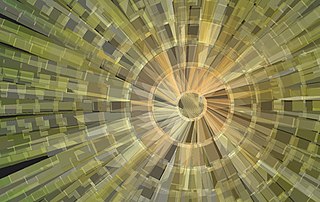
Evolutionary art is a branch of generative art, in which the artist does not do the work of constructing the artwork, but rather lets a system do the construction. In evolutionary art, initially generated art is put through an iterated process of selection and modification to arrive at a final product, where it is the artist who is the selective agent.

Generative art refers to art that in whole or in part has been created with the use of an autonomous system. An autonomous system in this context is generally one that is non-human and can independently determine features of an artwork that would otherwise require decisions made directly by the artist. In some cases the human creator may claim that the generative system represents their own artistic idea, and in others that the system takes on the role of the creator.
Interactive evolutionary computation (IEC) or aesthetic selection is a general term for methods of evolutionary computation that use human evaluation. Usually human evaluation is necessary when the form of fitness function is not known or the result of optimization should fit a particular user preference.

Przemysław (Przemek) Prusinkiewicz is a Polish computer scientist who advanced the idea that Fibonacci numbers in nature can be in part understood as the expression of certain algebraic constraints on free groups, specifically as certain Lindenmayer grammars. Prusinkiewicz's main work is on the modeling of plant growth through such grammars.
Neil Leach is a British architect and theorist. He is also a licensed architect, registered to practice in the United Kingdom.

Algorithmic art or algorithm art is art, mostly visual art, in which the design is generated by an algorithm. Algorithmic artists are sometimes called algorists.
Generative systems are technologies with the overall capacity to produce unprompted change driven by large, varied, and uncoordinated audiences. When generative systems provide a common platform, changes may occur at varying layers and provide a means through which different firms and individuals may cooperate indirectly and contribute to innovation.
Artificial development, also known as artificial embryogeny or machine intelligence or computational development, is an area of computer science and engineering concerned with computational models motivated by genotype–phenotype mappings in biological systems. Artificial development is often considered a sub-field of evolutionary computation, although the principles of artificial development have also been used within stand-alone computational models.
Dr Peter John Bentley is a British author and computer scientist based at University College London.

Architectural geometry is an area of research which combines applied geometry and architecture, which looks at the design, analysis and manufacture processes. It lies at the core of architectural design and strongly challenges contemporary practice, the so-called architectural practice of the digital age.

Digital architecture refers to aspects of architecture that feature digital technologies or considers digital platforms as online spaces. The emerging field of digital architectures therefore applies to both classic architecture as well as the emerging study of social media technologies.
Morphogenetic robotics generally refers to the methodologies that address challenges in robotics inspired by biological morphogenesis.

Michael Ulrich Hensel is a German architect, researcher and writer. His primary areas of interest and inquiry include performance-oriented architecture, embedded architectures - architecture and environment integration, and advanced data-driven design. His work is located in the intersection between architecture, landscape architecture, urban design, micro-climatology and ecology.
Birger Sevaldson is a founding member and current chairman of OCEAN Design Research Association and Professor at the Institute of Industrial Design at AHO - Oslo School of Architecture and Design where he collaborates with Michael Ulrich Hensel. He is an academic and designer working in a broad field of design and architecture. He has been in private practice since 1986. His practice spans from architecture interior to furniture and product design, design of lighting armatures and boat design. It also includes installations.

Generative design is an iterative design process that generates outputs that meet specified constraints to varying degrees. In a second phase, designers can then provide feedback to the generator that explores the feasible region by selecting preferred outputs or changing input parameters for future iterations. Either or both phases can be done by humans or software. One method is to use a generative adversarial network, which is a pair of neural networks. The first generates a trial output. The second provides feedback for the next iteration.
Design Automation usually refers to electronic design automation, or Design Automation which is a Product Configurator. Extending Computer-Aided Design (CAD), automated design and Computer-Automated Design (CAutoD) are more concerned with a broader range of applications, such as automotive engineering, civil engineering, composite material design, control engineering, dynamic system identification and optimization, financial systems, industrial equipment, mechatronic systems, steel construction, structural optimisation, and the invention of novel systems.

Neri Oxman is an Israeli-American designer and professor known for art and architecture that combines design, biology, computing, and materials engineering. She coined the phrase "material ecology" to define her work.

Rivka Oxman is an Israeli architect, researcher, and professor at the Technion Institute in Haifa. Her research interests are related to design and computation, including digital architecture and methods, and exploring their contribution to the emergence of new paradigms of architectural design and practice.
Systems-oriented design (SOD) uses system thinking in order to capture the complexity of systems addressed in design practice. The main mission of SOD is to build the designers' own interpretation and implementation of systems thinking. SOD aims at enabling systems thinking to fully benefit from design thinking and practice and design thinking and practice to fully benefit from systems thinking. SOD addresses design for human activity systems and can be applied to any kind of design problem ranging from product design and interaction design through architecture to decision-making processes and policy design.
Systemic design is an interdiscipline that integrates systems thinking and design practices. It is a pluralistic field, with several dialects including systems-oriented design. Influences have included critical systems thinking and second-order cybernetics. In 2021, the Design Council (UK) began advocating for a systemic design approach and embedded it in a revision of their double diamond model.









